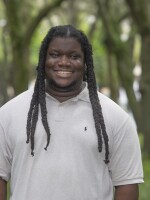The number of black first-year students at the University of South Florida has been steadily declining since 2014 — leaving the university looking for answers.
Figures from USF show 257 new undergraduate students admitted for the spring 2021 term identify as Black — down from 322 in spring 2020. Comparing fall 2019 to fall 2020, new Black undergraduate enrollment dropped from 664 to 581.
Enrollment for first-time in college Black students saw similar declines: 41 in spring 2020 to 31 in spring 2021, 195 in fall 2019 to 116 in fall 2020.
These numbers are puzzling when you consider that once enrolled, Black students graduate at a higher rate from the university than a majority of other races.
Paul Dosal, USF's vice president for student success at USF, says several factors could be leading to the decline.
“One of them is simply that over the last five to six years, maybe more, we've seen a change in the way that students identify (themselves),” he said.
“Back in 2010, this was changed as part of the (U.S.) Census guidelines. And so, over the same period of time, we've certainly seen a decline in students identifying as Black. At the same time, there's been an increase in the number of students who identify as multiracial, or who don't identify at all.”
In December 2020, the Helios Education Foundation gave the university a grant of $60,000 to hire an outside consultant to get to the root of this problem. The plan is to create an action plan to boost Black enrollment by June of this year.
“We’re three months into it, and our consultant was engaged in early to mid-January, and he took about a month to introduce himself and talk to a number of different stakeholders in the community and at USF,” said Dosal.
“At this point, he's identified some areas that he wants to explore in further detail, some further analysis that he wants to conduct. So we're looking at the application process and seeing if there's anything to be found there. Up next, I think we're going to be taking a deeper dive into the evaluation process to see if there's anything to be found there. Right now, we're full of questions, and we don't have many answers.”
Some of those answers may include advertising more to the local community.
USF has the Guaranteed Admissions Pathway Program, or GAPP, which allows local high schoolers to gain admission to the school by sustaining a 3.7 GPA throughout the end of their junior year and earning a score of 1100 on the SAT or 22 on the ACT.
However, the program has limits, leaving the university searching for ways to better reach out to the greater Tampa Bay community.
Glen Besterfield, USF dean of admissions, offered his thoughts about how the process is currently going.
“ I think we'll have a preliminary report in June, and that will probably ask more questions than anything then give answers, but at least they'll give us a direction. We're doing pretty good right now on black admits and Hispanic admits. Our black and Hispanic admits are up higher than our total number of admits, which is a positive sign at this point.”
According to the Tampa Bay Business Journal, USF is set for an overall increase in nearly every demographic heading into the summer/fall 2021 semester, including a 34% increase in Black admissions compared to summer/fall 2020, as of March 1.
This led Besterfield to say he’s remaining optimistic.
“This is a very challenging year, and when the pandemic happened back in March, I said the real problem is the class of 2022," he told the TBBJ. "They should be testing, and they’re not testing right now. The 2021 class probably tested their junior year and used those scores if they needed. So, we remain optimistic, but it will be tough,” he said.
Another factor that could make the recruitment process more challenging is a bill filed by Sen. Dennis Baxley in February that would change the state's Bright Futures program.
Originally, the bill would have allowed the Board of Governors and the State Board of Education to approve a list of career certificate, undergraduate and graduate degree programs that lead directly to employment.
The bill was significantly rewritten, limiting financial aid for students seeking degrees that the state doesn’t think will lead to future jobs instead of cutting it off completely.
While Dosal declined to comment on this subject from a university standpoint, he did offer some questions of his own about it.
“How is one going to determine what degrees lead to jobs? What are the years we're taking into consideration?
"Let me use myself as an example. I earned several degrees in history, and I imagine that would be one of the degree programs that people would have questions and concerns about because a B.A. in history doesn't necessarily lead directly to a job, right? Unless you were to get lucky and get a job at a local history museum,” he said.
“However, nearly 40 years later, I'm serving as the vice president for student success, and a history degree won't show up on any chart that says it's going to lead you to a position as an administrator in higher education.”
The Senate Appropriations Subcommittee on Education is set to consider Baxley's bill (CS/SB 86) Wednesday afternoon.




